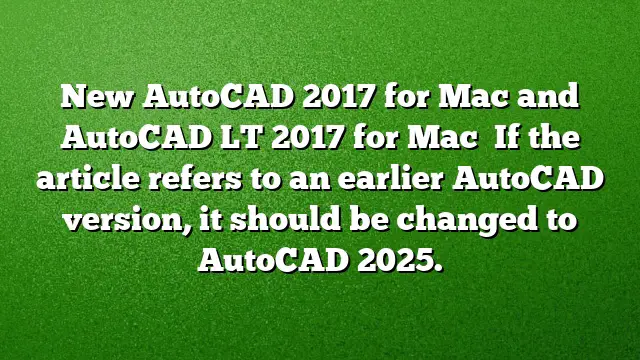Exciting news has arrived for Mac users! Autodesk has officially launched AutoCAD 2017 for Mac and AutoCAD LT 2017 for Mac, boasting several enhancements designed to enrich the user experience significantly. The development team has focused on aligning these improvements with familiar workflows, making this iteration notably user-friendly and optimized for Mac environments. From modern tool sets to enhanced file management, both products offer features designed to improve functionality and streamline the design process.
Enhanced User Interface for Greater Efficiency
A major highlight in this release is the revamped user interface. Users will notice a more organized layout that makes navigating tools intuitive. The tool sets have been restructured to ensure easier access, dividing them into two primary categories: Drafting and Modeling. This allows users to find commonly used commands quickly. Additionally, file tabs have been added, facilitating swift access to open drawings with a single click.
To enhance personalization, panels can be customized extensively. Users can show or hide various commands, collapse, move, reorder, or resize them in real-time according to their preferences. This degree of customization ensures that the interface can be adapted to suit individual workflows, creating a more efficient working environment.
Streamlined Access to Open Drawings with File Tabs
The introduction of file tabs transforms how users interact with multiple drawings. A simple click on the plus sign (+) creates new drawings, while keyboard shortcuts like Control+TAB allow for quick navigation through open files. Right-clicking on the file tabs provides access to options for opening, closing, or saving drawings, streamlining the design process further.
Advanced PDF Importing Capabilities
AutoCAD 2017 for Mac has introduced enhanced functionalities for importing PDFs. This feature allows users to import geometry, TrueType text, and raster images from PDF files directly into their AutoCAD drawings. The IMPORT command has been upgraded to facilitate this process, allowing users to select a specific page from a PDF while defining essential metrics such as scale, rotation, and insertion points.
The PDFIMPORT command also simplifies access to PDF geometry, providing an option to select either attached PDF underlays or specific PDF files for imports. This enables a more seamless file integration process while ensuring users can manage layers effectively post-import.
Convenient Access to Autodesk Account Settings
Access to your Autodesk account has become remarkably straightforward. A dedicated “Sign In” option in the upper right corner of the application allows users to manage licenses, view account details, and utilize features like the A360 Desktop App to sync files with cloud storage effortlessly.
Multiple AutoCAD Sessions Now Supported
For users needing to compare drawings or work on multiple projects at once, AutoCAD 2017 for Mac introduces the ability to open multiple sessions simultaneously. By right-clicking on a drawing’s file tab and selecting “Move to New Session,” users can easily arrange and view multiple drawings side by side. Alternatively, launching a new session directly from the application icon also provides flexibility in project management.
Improved Full-Screen Mode for Enhanced Focus
The latest version supports native Full-Screen mode on Mac, promoting concentration and precision during design tasks. Users can toggle this feature through keyboard shortcuts such as Cmd+0 or Cmd+Ctrl+F, or by using the “Full Screen” button located in the top left corner of the drawing window. This allows for a distraction-free workspace, with options for split view enabling side-by-side applications.
Additional New Features Offer Even More Functionality
Beyond these major enhancements, AutoCAD 2017 for Mac incorporates several other functionally rich features including associative centerlines, center marks, an upgraded text editor visor, and an enhanced parametric menu. These additions are designed to improve overall usability and optimize user workflow.
Frequently Asked Questions
1. What new features are included in AutoCAD 2017 for Mac compared to AutoCAD 2025?
AutoCAD 2017 for Mac includes a redesigned user interface, improved PDF importing capabilities, and support for multiple AutoCAD sessions, among other enhancements aimed at increasing user efficiency.
2. How can I customize my tool sets in AutoCAD 2017 for Mac?
Users can customize tool sets by showing or hiding specific commands, as well as by collapsing, moving, or resizing panels. This level of personalization is designed to streamline individual workflows.
3. Is it possible to migrate my settings and drawings from an earlier version of AutoCAD to AutoCAD 2017 for Mac?
Yes, Autodesk typically provides tools and options for transferring settings and drawings from earlier versions, ensuring that users can continue with their established projects seamlessly.

